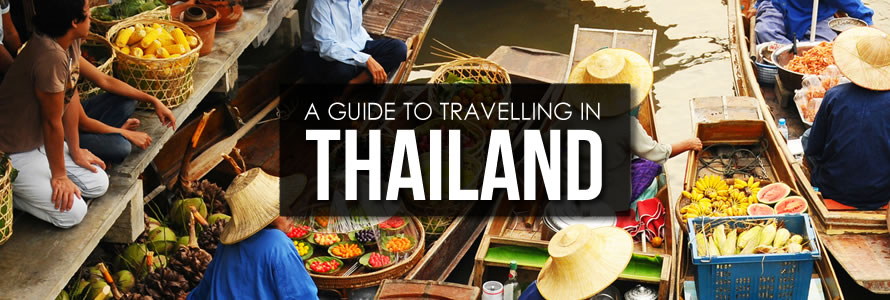From fantastical temples which glitter in the sun to beaches which instantly satisfy any cravings for palm-fringed paradise, Thailand has all kinds of things which make it a popular destination. Its jungles, ancient ruins, culture, wildlife and landscape place it firmly in the highly exotic category but its amazing tourist infrastructure and wonderfully welcoming people make it ideal for even the total novice traveller.
Add into all that a fantastic cuisine known the world over and its rock-bottom prices (even for places to stay and experiences which might rank as luxury elsewhere) and it is easy to see why Thailand is such a magnet not just as a darling of the backpacker crowd but also as a destination with something for everyone.
Our Thailand travel guide will give you a quick fact summary of all the essential elements of visiting this incredible country.
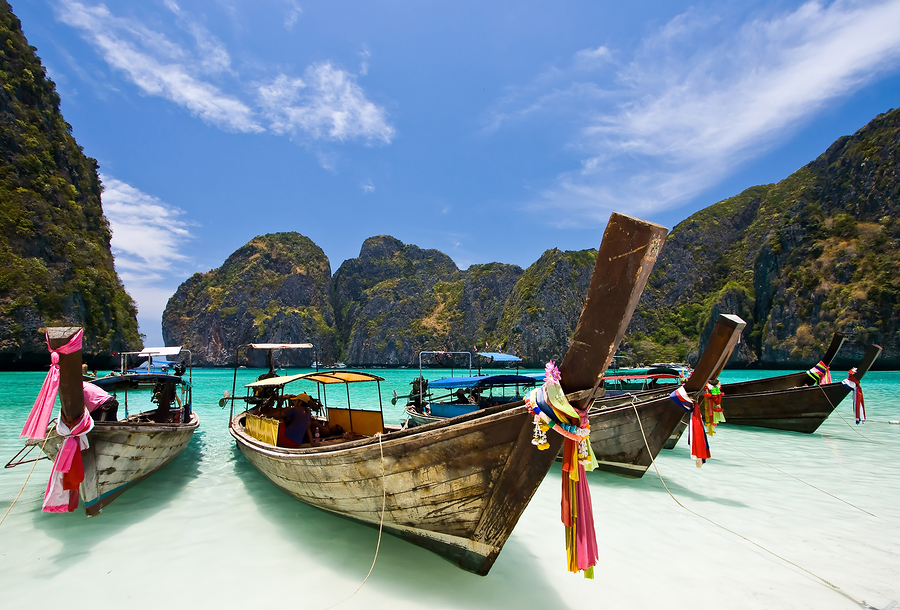
Visas
For the majority of visitors – including those from Europe, Australia, New Zealand, the UK, the US and Canada – entering Thailand is straightforward as visas on arrival or visa exemption agreements are in place. Quite how long this is valid for depends on which country you are from but in most cases it is 30 days. For most nationalities this is less – 15 days – if you enter Thailand by crossing a land border rather than arriving by air. For those who want to stay in Thailand longer visa extensions are possible. A fee is payable and you will have to make a visit to an immigration office.
As applying for extensions or leaving and re-entering Thailand to get another visa can seem like a lot of hard work, some people choose instead to overstay and then pay the fine which accumulates for every day a person remains in the country past the visa expiry date. Although doing this is far from rare just be aware that if you get an awkward official things might get a little more awkward and time-consuming than you envisaged.
More information on entry requirements for Thailand can be found here.
Weather and Seasons in Thailand
As is the case with most equatorial and tropical countries there are really only two distinctly different seasons – the dry season and the rainy season. Temperatures remain hot to very hot year round – usually between 28-35°C during the day – and humidity is typically high too. April is usually the hottest month (just before the onset of the rainy season) and in the more mountainous regions in Thailand’s north temperatures can be considerably lower than they are at sea level and even chilly at night.
Although there can be some variations depending on which part of the country you are in the rainy season typically runs from the end of May/beginning of June to October. Downpours can be sudden and torrential but they are typically short-lived (and be aware that the dry season doesn’t mean there will be no rain at all). Some of the islands are practically deserted during the rainy months with reduced to zero transport options for even getting there.
People will also talk of high and low seasons too. The former runs from November to March and is when Thailand receives more visitors as temperatures are typically at their most comfortable and it rains little. Expect prices for accommodation and activities to be at their peak during these months.
Accommodation Options in Thailand
Where accommodation options are concerned Thailand has it all – from the mega-cheap and basic to the height of luxury. There are an especially vast number of budget-friendly options which makes it a popular destination for backpackers and those on a shoe-string budget.

Hostels – Hostels are everywhere in Thailand and are typically the cheapest option if you are happy to take a dorm bed. Hostels come in every guise and every size – there are those which have all kinds of facilities such as swimming pools and restaurants, those which include breakfast or other meals, flash-packer type options which provide extra comforts and so on. Typically hostels will offer at least one common area for mingling with fellow guests.
Guest-houses – These are as common in Thailand as hostels and in some places outside of the cities even more so. Many of these – especially those which offer shared bathroom facilities – are as cheap as hostels. As with hostels though they come in every form. Some are little more than a windowless box with a bed while others are homely with all kinds of comforts and extras included.
Beach huts – If you have some image in your head of your very own little thatched hut which sits directly on the tropical palm-fringed beach it isn’t hard to realise this dream in Thailand. Depending on the location and season beach huts can also be as cheap as hostels. Also, like hostels and guest-houses, they sometimes come with private bathrooms while others offer shared facilities. The latter are typically the cheapest option.
Homestays – Away from the cities homestays are a popular choice especially for those who want to experience a little of authentic Thai life with a local family. For those to whom this is important it pays to be sure of what you are getting though. The title homestay is not always used in its truest sense and some are really guest-houses where the only time you might be able to interact with your hosts is when they serve you breakfast. A true homestay means being part of a family for the entire time you are there – sharing meals, sometimes sleeping spaces and every aspect of day-to-day life.
Hotels and resorts – In the bigger cities and more popular islands you will have no problem finding hotels in every category – from basic to top end international chains. If you are looking for one of those all-inclusive ultimate luxury kind of resorts they are plentiful in Thailand, especially in the islands.
Thai Culture
With the exception of destinations in the south of peninsula Thailand where it borders Malaysia the majority of Thailand is Buddhist – around 94% of its people in fact. Almost all Thai males will have passed a period as a novice monk – usually for a few months in adolescence or as a young man. Such a strong Buddhist culture makes for all kinds of plus points for the traveller (aside from the multitude of stunning temples) such as violence and even raised voices being rare.
This element also carries with it a few possible opportunities for cultural slip-ups although, because Thais hate confrontation and will rarely say anything, you will often not even know it. This gives you an even greater responsibility to do a little homework to try and avoid inadvertently offending someone.
The following are a few of the more common cultural differences it can pay to be aware of.
Entering temples – You should never enter a temple without wearing clothes which cover both shoulders and knees. While Thais tend to overlook most Western behaviour which they might deem a little odd this is one exception. If you are not dressed appropriately you will be denied entry. In some of the bigger temples – such as those in Bangkok – there are folk waiting around outside to rent sarongs as emergency cover-ups for any foreigners caught out. You will also have to remove your shoes (something which will also be expected in private home and even some public places such as shops). Once inside the temple it is considered offensive to turn your back on any Buddha images (so plan those photos carefully) and if you sit down on the floor be sure to have your knees tucked under you so your feet are not pointing at any Buddha images or statues.
Buddhist monks – Women are not allowed to have physical contact with monks which includes sitting next to them on buses. In more extreme cases monks are not even supposed to accept anything directly passed hand to hand from a female.
Heads and hands – In the Buddhist belief system feet are considered the dirtiest and heads the most sacred parts of the body. Although this is quite an extensive subject all of its own the most basic rules are never use your feet for moving things or touching people and never step over someone even if they are lying flat out on the ground.
Hand signals and gestures – Several of these are very different to what you might be accustomed to. The most common is the gesture for ‘come here’. Westerners tend to do this with palm up, Thais do it with palm down.
Dress – While those Thai destinations known for their night-life and party crowds (most significantly many of the islands) have become more accustomed to bikinis and beach-dress in the streets it doesn’t mean Thais like it. In more rural areas wearing t-shirts without sleeves which leave your shoulders bear and short shorts can be viewed as quite shocking. If you are female be prepared for certain kinds of leers and sexual attention in these cases if you don’t want to conform. In the eyes of many Thais only women of loose morals dress this way.
Thais don’t like to say no – Thais have a justified reputation for being kind and helpful and if you spend any prolonged time in the country you will see this time and again. The downsides to this are few but one such is that because Thais want to help they hate to say no. So, if you ask directions to somewhere and the person you happened to ask doesn’t know they will be unlikely to tell you so but instead send you off quite possibly in the wrong direction. This is also part of the ‘saving face’ element of Thai culture – something which means avoidance of feeling awkward or embarrassed or causing another to do so at any cost.
Overt emotions – You will rarely hear Thais raise their voices in angry exchanges. Of course Thai people get angry and sad like the rest of us but any emotion considered negative is generally kept very private and certainly not displayed in public. That means should you get a little rattled with that tuk-tuk driver who you know is overcharging you, you are going to attract attention and get absolutely nowhere with displays of verbal aggression. This whole thing also extends to public displays of affection. Even husband and wives barely touch in public and cuddling and kissing where others can see is nothing short of scandalous to many Thais.
Spirit houses – These are found everywhere in Thailand although many visitors are not even aware of their purpose. So that mischievous spirits stay out of the house Thais provide them with their very own little place to stay and just about every building, shop and home has something. In the humbler establishments this might look like nothing more than a little roofed bird table on a pole while grander places might have quite elaborate affairs.
Royalty – Thais take their royalty very seriously. To Western eyes it would almost appear as if kings are treated as gods. Making any kind of joke or disparaging remark about the royal family is an absolute no-no which can actually result in imprisonment. Such reverence extends to any photos or paintings so be respectful with bank notes too as these carry the king’s image.
Eating with Thai families – If you are lucky enough to be invited into a private home to eat or even intend staying in a true homestay it is worth knowing something of the meal etiquette. In most cases individuals have their own portion of rice but otherwise the dishes are set out in the centre of the table and intended for sharing by everyone.
The national anthem – If you happen to be somewhere public at either 8 am or 6pm such as a market or bus station you will hear the Thai national played over loudspeakers. Everything stops for these couple of minutes including people who freeze in position. If you want to be respectful you should act likewise.
Thailand’s Food & Drink
With Thai food being such an international favourite there will be few who haven’t experienced something of this cuisine before even setting foot in the country. However, even for those who frequent Thai restaurants and takeaways on a weekly basis in their own country there will be all kinds of new discoveries to make too (not least of all that dishes in Thailand tend to come in rather spicier varieties than their equivalents back home). Thailand is nothing short of a never-ending wonderful adventure for those with any kind of interest in food.
While much of Asia offers a street-food culture Thailand is perhaps king of them all. No hunting down required – it will be everywhere you go and sometimes there will be whole streets of it. Most markets will typically have a section set aside for food carts and stalls serving up everything from deep fried delights served on a stick to sweet treats beyond count.
Westerners can sometimes be a little over-cautious where street food is concerned and seem convinced that food-poisoning is an inevitable outcome. If this was indeed as big a risk as the squeamish believe then the Thai population would have been severely depleted by now because these wonderfully cheap options are as big a favourite with the locals as they are with visitors.
While bags of grasshoppers or scorpions on a stick might not be for everyone it pays to be a little adventurous with street food because it will be impossible to know exactly what you are getting sometimes unless you have been brushing up on your Thai and can ask. In many cases such as with soups and noodle dishes your food will be cooked for you as you watch so if it seems like anything is being thrown into the pot you don’t like the look of you can just say no.
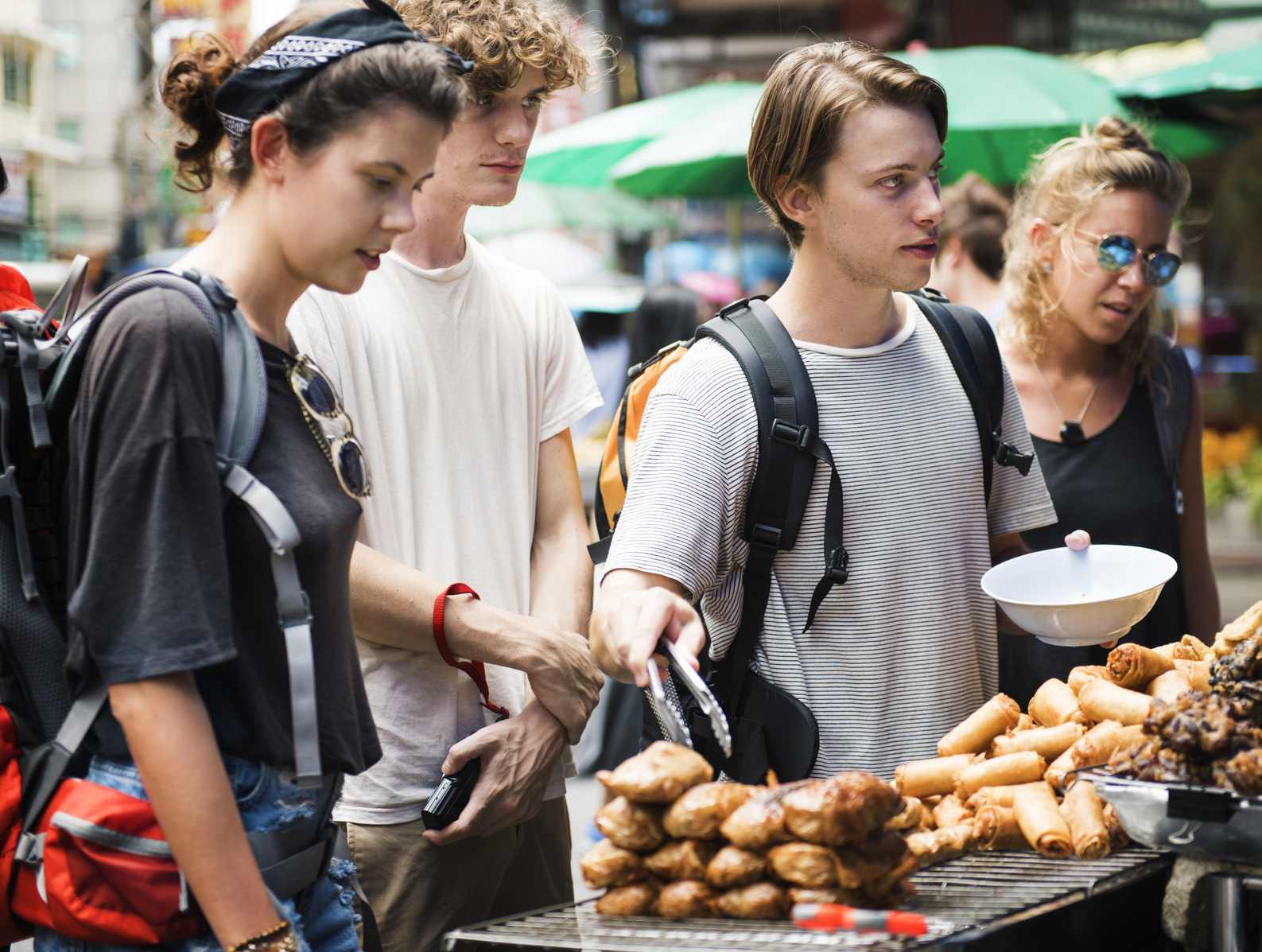
Fish and seafood feature heavily in a lot of Thai dishes especially on the islands and near the coasts and of course, rice, noodles, curries and a multitude of spices are a big feature everywhere. Many Thai dishes are typically spicy hot with plenty in the blow-your-head-off category. If this is more than you can handle you are not going to starve – just learn the Thai words for not spicy so the fierier spices and chillies can be left out in the preparation of your food.
Restaurants come in every shape and size too. At the lower end your eatery might be nothing more than a hole in the wall in a tiny alleyway with a child-size table and chair outside while at the upper end of things can be found five star choices for discerning diners.
If simply eating is not enough and you want to create your own Thai meals cookery classes and courses are mega-common offering everything from a few hours to a few weeks tuition.
Where drinks are concerned, juice or smoothie bars which offer endless combinations (some of which are going to be whole new sensations for your taste buds) are a common find in Thailand while a Thai classic is the vibrantly orange drink known as Thai iced tea. Thailand has a handful of its own beers, the most well-known of which are Chang (quite strong) and Singha. These will always be your cheapest options although international brands are easily available if you don’t mind paying more.
Safety & Health Issues
For the majority of visitors Thailand is a fun-filled a trouble-free destination but there are a few things it pays to be aware of.
Crime – While petty theft can be a problem – just as everywhere else in the world and especially in cities– violent crime is rare in Thailand, not in the least part due to the Buddhist culture here. Just as anywhere else in the world don’t flash cash or valuables in the street and keep a very close eye on belongings when travelling on public transport. Thefts on buses are far from rare.
Scams – While crime is relatively rare scams are not and at times it seems like there is no end of ways in which these are being practised on unsuspecting foreigners. Some are just annoying such as the cheap tuk-tuk ride which is really just a way to get you to visit the shop of a friend or relative and buy their goods. Others such as the rental motorbike scams can be very costly and there are others yet – especially those regarding selling drugs – which can land you in jail. The subject of scams is one which could take up a whole book so it pays to so some advance research here or at least make some enquiries at your accommodation for what to try and avoid.
Motorbike accidents – It is far from a rare sight – especially on the islands – to see foreigners in plaster casts, on crutches or with smashed up faces as a result of a motorbike crash. Renting motorbikes to get around is a popular thing to do because they are available everywhere and cheap. But the mix of hot climate (which means shorts and shirt are the standard dress instead of protective gear), the presence of some shockingly bad driving by others and the sometimes terrible states of the roads (or dirt tracks) can make for a lethal combo even in quite slow speed prangs. If you want to go down the motorbike hiring route and you are not an experienced rider you will need to be exceptionally careful.
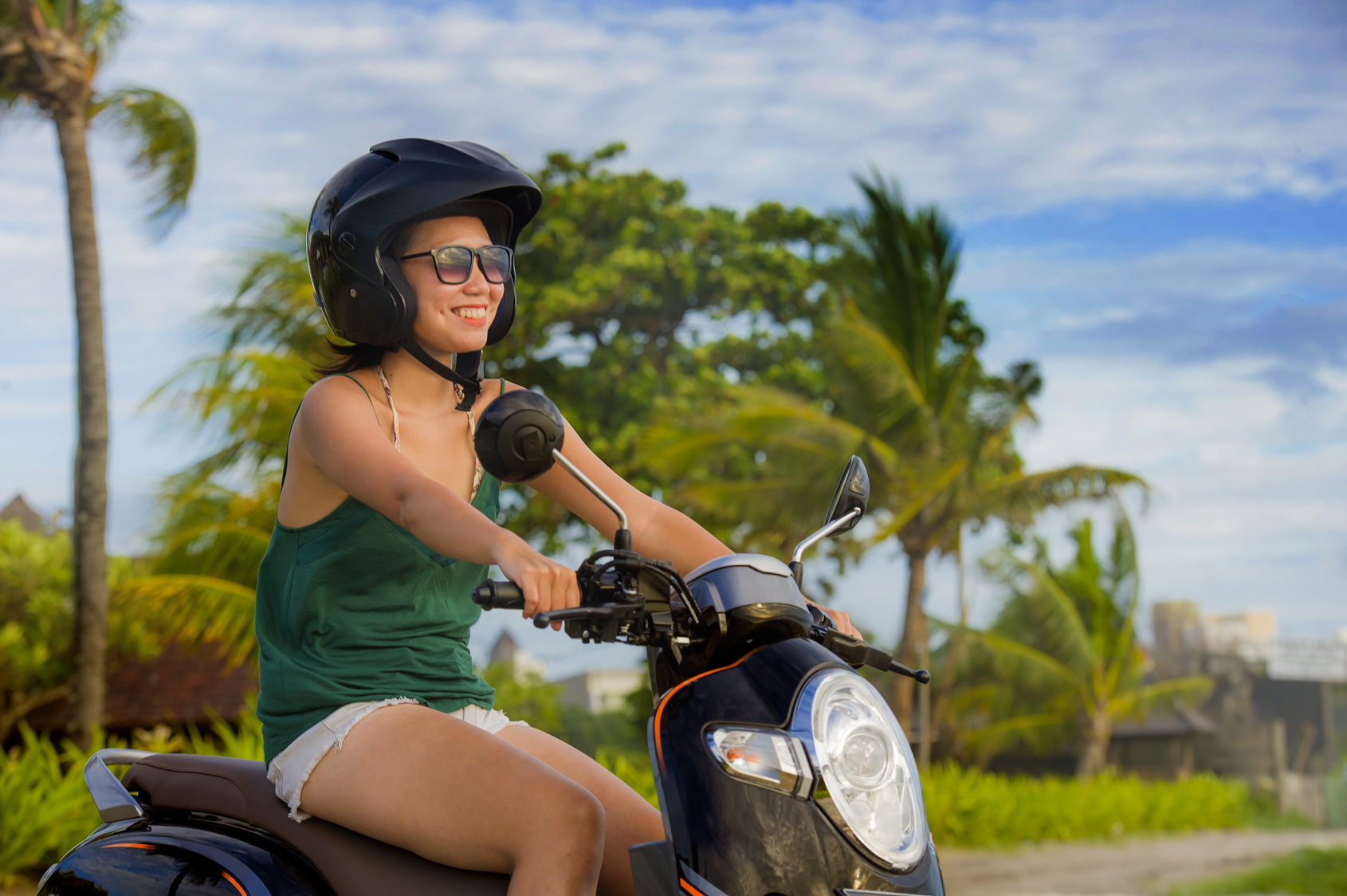
Street dogs and temple monkeys – There are a high number of street dogs in Thailand not all of which are actually strays. Many of them are aggressive and territorial and even those that actually belong to someone tend to be so too; Thais tend to keep dogs more as guards than pampered pets.
If you go for a wander somewhere rural it is not unusual to find yourself suddenly surrounded by barking dogs (who very definitely are not trying to be your friend) if you pass any kind of dwelling. Some of these dogs do bite and as rabies is present in Thailand it pays to be on your guard.
Temple monkeys are another hazard. Although the image of a troupe of monkeys living in some ornate and exotic temple on a hillside can seem very idyllic the truth is many of these animals can be aggressive to visitors and people do get bitten. If you are carrying any kind of food the monkeys may well make a beeline for you and they are not good at taking no for an answer. Waving a stick is normally enough to keep them at bay.
Snakes – There are a lot of snake species present in Thailand and more than 80 of them are venomous. In the majority of cases snakes will be aware of your approach way before you ever see them and will be long gone by the time you arrive. However, it pays to be a little vigilant especially if you are walking in places that are known to have snakes.
Natural risks – Active volcanoes are not present in Thailand and although the country experiences occasional earthquakes they are typically low-strength. The greatest natural hazards are those of landslides and floods in the rainy season. Thailand also sits in a tsunami risk zone and following the large scale 2004 tragedy there are few who visit here who are not aware of this. Early warning systems have been installed since then and if you are in a coastal area at risk there are many signs with advice.
Health risks – Both Malaria and Dengue Fever are present in Thailand with outbreaks of the latter very common. There is also a moderate risk of Zika Virus transmission. While there are preventative medicines for Malaria there is no vaccine or preventative medication for Dengue Fever or Zika, which are transmitted by a day-flying mosquito. The only way to protect yourself from Dengue Fever and Zika is to use a mosquito repellent throughout your trip.

Sun exposure – While sunburn can be uncomfortable the greater risks of tropical sun exposure are dehydration and heatstroke. Humid climates mean a high level of sweating and because this can’t be absorbed so quickly by the moisture-laden air your body’s natural system for cooling down is less effective. Excessive overheating can lead to heatstroke and this can be a killer. Your body will adjust to the heat and the sun to some degree but you have to expose it slowly and no matter how long you have been in the country keep a close eye on your fluid intake, especially if you are having some fun in the sun with alcohol involved.
Upset stomachs are another common health hazard which in most cases are just a 24 hour thing as your body adjusts to its change of environment. Take extra care of any cuts or scratches no matter how minor they appear. Wounds don’t heal as quickly in the tropics and if infection sets in the result can be tropical sores which can be serious.
If you do get sick it is worth noting that health care in Thailand can either be as good as it gets or a nightmare. While some of the public hospitals are places you are going to want to avoid Thailand also has many state-of-the-art hospitals with foreigners coming from far and wide specifically to use their facilities – a phenomenon known as medical tourism.
Language
While there are regional variations, dialects and indigenous languages the official language in Thailand is Thai which has its own alphabet. There is no standardisation for converting the Thai script into the Roman alphabet and as a result if you do see something written using this latter alphabet there may be a great variation in the spellings which can be confusing for visitors. One of the most common for these is the Thai word for island so you might see it written as either ko or koh.
While learning to at least say the basics such as please, thank you and hello in any country you are visiting is something both respectful and helpful it is especially rewarding in Thailand. Even if you master just a few simple phrases anyone you encounter will be thrilled and tell everyone around them that you speak Thai.
In the tourist centres it isn’t unusual to find English speakers (and indeed those which speak several languages) but it is far from universal and once you are off the beaten path anywhere it is rare. Smiles, mimes and a good phrase book can usually get you understood and is all part of the fun and adventure.
Money Matters in Thailand
The baht is the country’s official currency. ATMs are everywhere except for the most remote destinations such as some of the lesser visited islands but be aware that these typically charge a fee – some more than others. You will have no trouble using major company credit cards in the larger establishments such as shops, restaurants and hotels but they will be useless elsewhere. While tipping is not a major part of the culture haggling is – most notably in markets.
Transport Options in Thailand
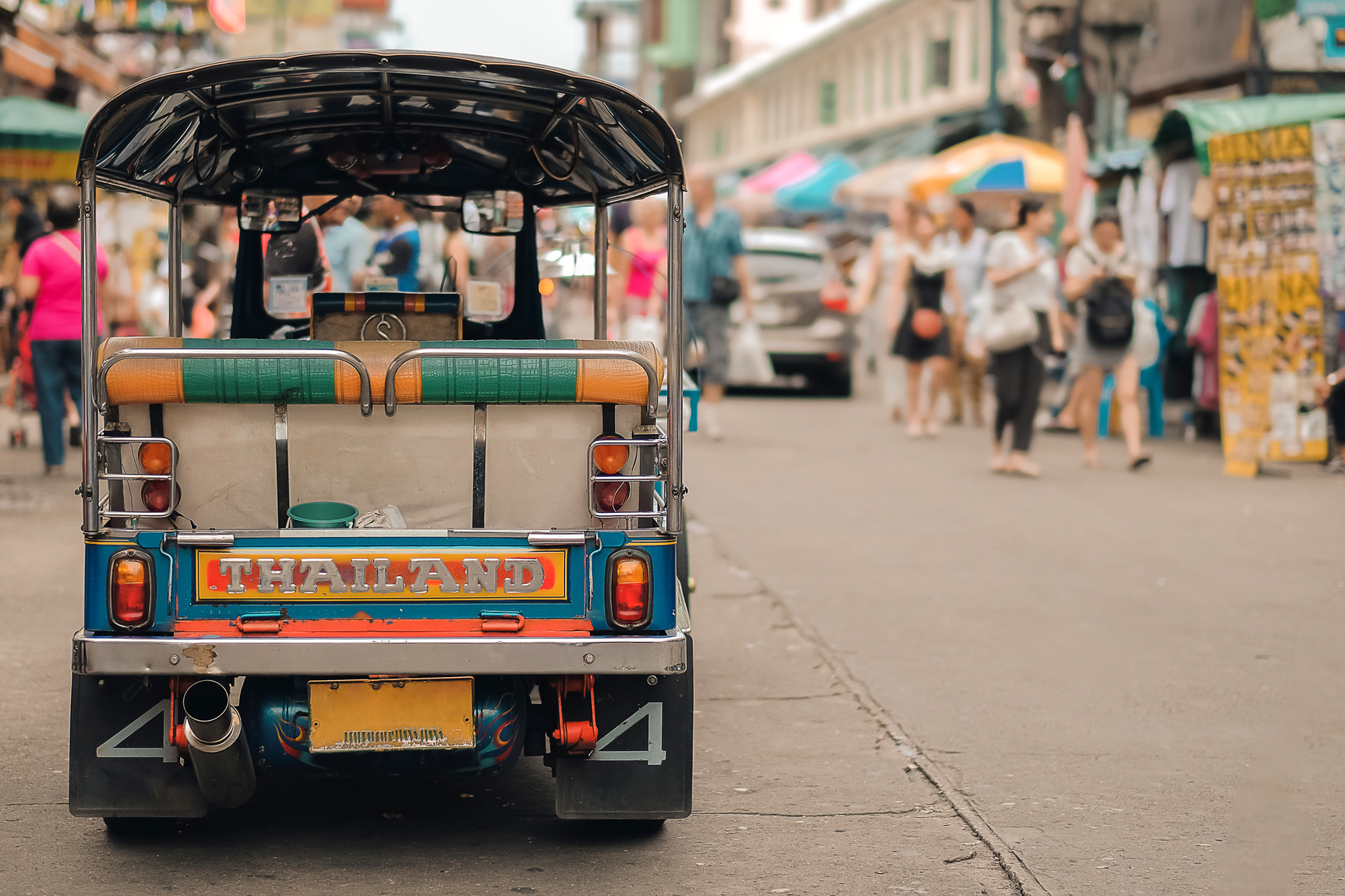
Air – Thailand has a number of domestic airline operators which serve both Thailand and bordering countries. While this is never going to be your cheapest form of travel it is highly affordable even for those on tight budgets so it pays to check out these options if you have limited time to spend on long bus or train journeys. Bangkok is the hub but there are a handful of other destinations – Chiang Mai, Phuket and Hat Yai for example – which offer routes that don’t go via the capital.
Bus – Thailand’s bus network is vast. Even the most out of the way towns and even many villages have a government subsidised station (BKS) which can be anything from a dusty patch of ground to a multi-floored complex with cafes and shops. The services which operate from these places can be either state-owned or private companies.
When buying a ticket it helps to know that buses come in a variety of forms, especially for longer journeys. The cheapest options are those which visit every village on route or seem to stop every few seconds to take on another roadside passenger who has flagged it down. This can be fun for local runs but longer distance journeys can be tortuous. From there the options increase in price and comfort levels to super VIP classes. The better buses come with air-con, toilet facilities, reclining seats, water and snacks and even sometimes a stop for food which is included in the price.
Extra clothes are essential on longer journeys on the higher class of buses because the air-con is always set to Antarctic levels and stays there for the entire journey.
Mini-van – Most of the major destinations are linked by minivans which often operate out of an office. Don’t assume these will be more comfortable journeys because some companies really pack them full although some will deliver you directly to the door of wherever you want to go.
Train – Thailand has five major railway lines which connect a huge number of destinations although all originate from Bangkok. Train travel in Thailand can be an adventure in itself with wonderful scenery typically thrown in for free. In general there are three classes of train with third class being the cheapest and most basic with bench seating. Second class offers more comfortable seats in a configuration similar to buses while first class is typically a private cabin. Be aware that quite what you get for your first, second or third class ticket price can vary depending on whether the train you are on is deemed ‘express’, ‘rapid’ or ‘ordinary’.
Sleeper trains are a common thing on the longest routes and again ticket types vary in price and comfort. The cheapest options simply provide bunks (converted from the daytime seats) lined up along the train with just a curtain for privacy to relatively comfortable private cabins with their own air-con and bathrooms. Not all trains offer all classes. For example some of the shorter routes only offer third class travel while some trains have no third class at all.
While buying tickets at the station for immediate travel is possible there are many routes – especially the sleeper train routes – which will require an advance reservation.
Bangkok also has both an over-ground (BTS – Skytrain) and underground (MRT) railway system which makes getting around the capital super-easy.
Boat – With so many of Thailand’s must-visit destinations being on islands it is highly likely that you will encounter boat travel of some kind during your Thai explorations. These come in a variety of forms.
Long-tail – Sometimes covered by a canvas roof, sometimes open to the elements, these colourful boats are typically used for ferrying passengers from island to island or for shorter journeys on rivers or the canals of Bangkok.
Ferries – Bangkok has an incredibly cheap and extensive ferry system for travelling along and across the river known as the Chao Phraya River Express. Used by both tourists and locals these ferries can be boarded from a huge number of piers along the river.
Elsewhere in Thailand the word ferry can mean any number of different water craft which are principally used for getting passengers from the mainland to the islands or between islands in a group. The fastest ferry options – and the most expensive – are speedboats.
Other craft – Besides the ubiquitous long-tail and the ferries quite what you might encounter as a means to travel across water as you travel Thailand can vary considerably. In the mix are everything from bamboo rafts (usually not actually made of bamboo) to luxury yachts.
Hitch-hiking – Although most guide books and tourist literature (as well as your Mum) will advise against hitch-hiking for its obvious risks it is a very commonly used means of transport for many Thailand travellers, especially those on a budget. Because of the high occurrence of open-backed trucks you don’t even have to get inside the vehicle.
Be aware that the more usual jerking thumb gesture used elsewhere in the world to indicate you are trying to hitch a ride is not used in Thailand. Instead wave you hand with your arm extended and your palm facing down.
Local transport options – There is a huge variety of transport options for getting around cities and towns some of which are a lot of fun.
Tuk-tuk – Those who have been to Thailand and not travelled in a tuk-tuk at least once must be a rare breed; these little 3-wheelers are literally everywhere. In the biggest tourist centres tuk-tuk drivers have something of a reputation for ripping off visitors so always be clear of the price before you get in. However, it is worth bearing in mind before you get too frustrated and heated that you are probably arguing over the equivalent of about 30p.
Sorng taew – Often filling the niche of local buses, these covered, open-backed trucks with benches are usually the preferred option for the locals as they are the cheapest option. Most cover set routes and can be hailed at any point along these route with the fare paid as you get off.
Motorbike taxis – These are also found everywhere – from the cities to the tiny islands – and in some instances might be your only option. Don’t think that if you are loaded down with a big backpack or luggage this type of transport isn’t possible – these guys seem to be able to juggle anything.
Pedicabs – Sometimes 3-wheeled trikes and sometimes an ordinary bicycle with a seat behind or at the side, this type of transport is pedalled by a ‘driver’ without the help of any kind of a motor. These types of local transport are not seen that often but they do still exist in some of the smaller towns and out-of-the-way places.
Taxis – Taxis can usually be found in most cities and towns although outside of Bangkok these are not always metered which makes it essential to agree a fare at the outset.
Bike – Renting a bike is usually very cheap and places for doing this can be found everywhere – often directly from your hostel or guest-house. While trying to dodge other road-users on a bike in Bangkok probably won’t appeal to many there are plenty of places with little or no traffic which makes hiring a bike a lot of fun. Some of the historical parks such as Sukhothai are so vast renting a bike to take in all the sights is very common.
Essential Highlights for Thailand
Islands – From dusk ’til dawn party central to Robinson Crusoe-like escapes – Thailand has an island for every kind of traveller no matter whether your intention is to find action and adventure or complete retreat. In some cases islands manage to be all things to all people such as Ko Tao which offers plenty of after-dark fun or diving schools on one side of the island or tranquillity and natural beauty on the other. No matter whether an island has seen high development or stayed unspoiled silky white sands and crystal clear turquoise waters tend to come as standard.
Although there are far too many islands to cover here those who are looking for crazy abandonment should head to Ko Phangan – home to the original full moon party – while those in search of an unspoiled hideaway should check out Ko Tarutao. You can hire a tent and camp directly on the beach here and if you time it right your only company will be the monkeys.
Bangkok – Thailand’s capital city has enough essential highlights to keep a visitor busy, excited and blown away for months without heading anywhere else. Floating markets, Muy Thai exhibitions, museums, canal and river tours, temple complexes, cabaret and amazing nightlife – Bangkok has all you might expect and heaps of things you couldn’t imagine until you are here. If you do nothing else a visit to the Grand Palace is a must. With 150 years of royal residency history and a conglomeration of fantastical buildings, the sheer scale of the glittering Grand Palace complex is almost too much to take in and offers a wonderful sensory overload.
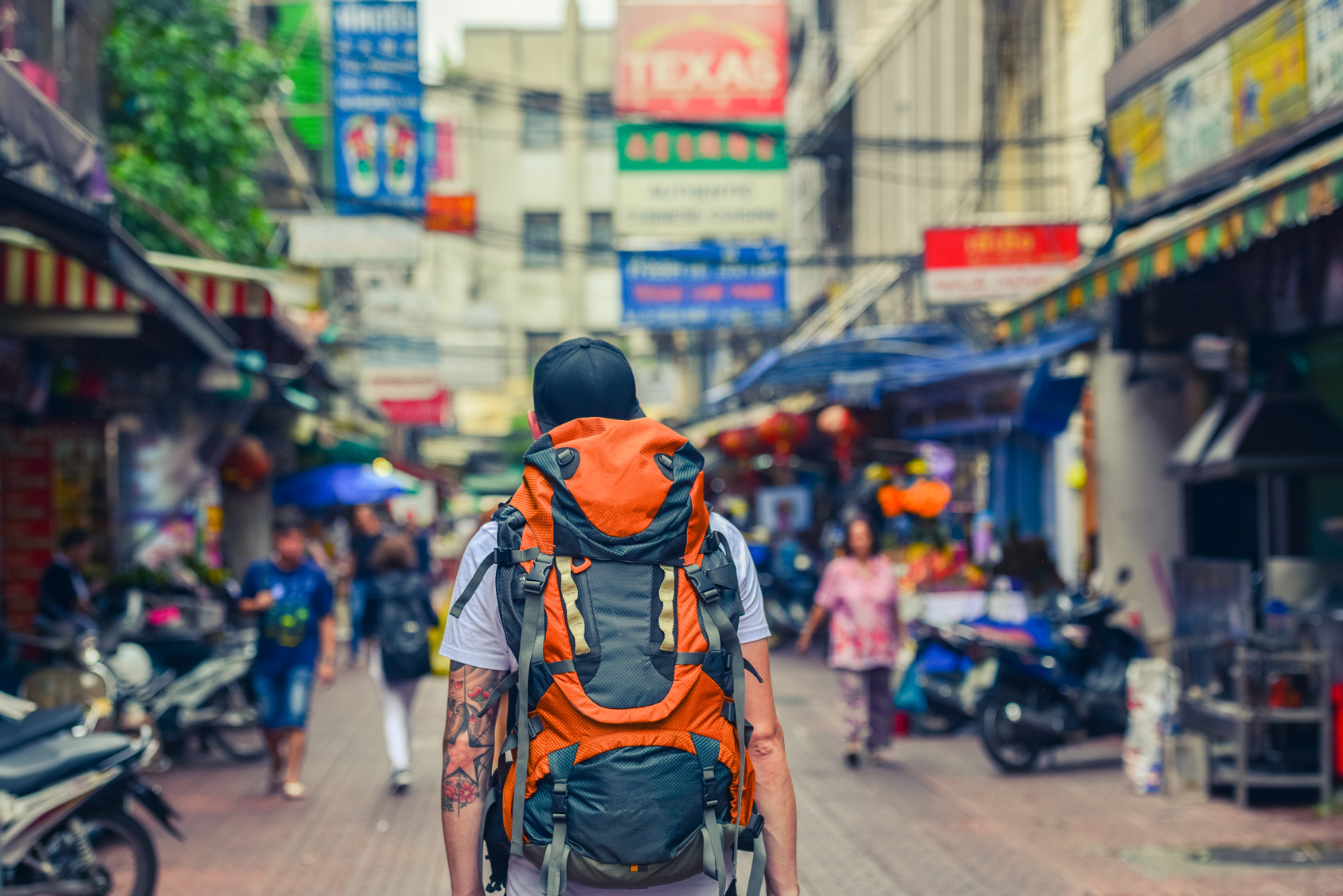
World Heritage Sites – Thailand has five UNESCO World Heritage Sites which means you can expect something way out of the ordinary. Two of these – Sukhothai and Ayutthaya – are sprawling complexes of temples, palaces, incredible statues and buildings left over from ancient times.
Learn to dive – The possibilities for learning to dive and achieving all levels of dive qualifications at rock-bottom prices are so extensive in Thailand that some travel from every corner of the globe for that reason alone. While options are found in any number of places near to a coastline Ko Tao is one of the most popular while live-aboard possibilities – especially for the idyllic Similan Islands – are also easily found. If a whole course doesn’t appeal sign up for one of the ‘try dive’ trips which allow you to get among the coral gardens and fascinating underwater world teeming with life for a quick one-off experience.
The White Temple or Wat Rong Khun, Chiang Rai – While the presence of thousands of stunning temples in Thailand can leave even the biggest addict feeling a little templed out there are some which are so exceptional they shouldn’t be missed. One of these is Chiang Rai’s mind-blowingly beautiful Wat Rong Khun. Part fairytale castle, this modern temple complex is made up of nothing but white surfaces and silver mosaic tiles which are dazzling on a sunny day. There are some major surprises here which include modern-day movie monsters emerging from the ground, possibly the world’s most opulent public toilets and a mural on the back wall of the temple which incorporates Harry Potter, Hello Kitty, Angry Birds and Superman. The pathway approach to the temple takes you over a sculpture-filled pit filled with disembodied hands and hundreds of skulls, the details of which could keep you busy for hours.
Markets and floating markets – While most markets of the world tend to give the visitor a firm reminder they are somewhere different and exciting nowhere is this truer than in Thailand. Thailand’s markets serve as instant immersion into the exotic. In the mix are night markets and bazaars bursting with energy, colour, traditional entertainment and music while around Bangkok there are several floating markets. If you are a street food fan markets are usually a great place to head.
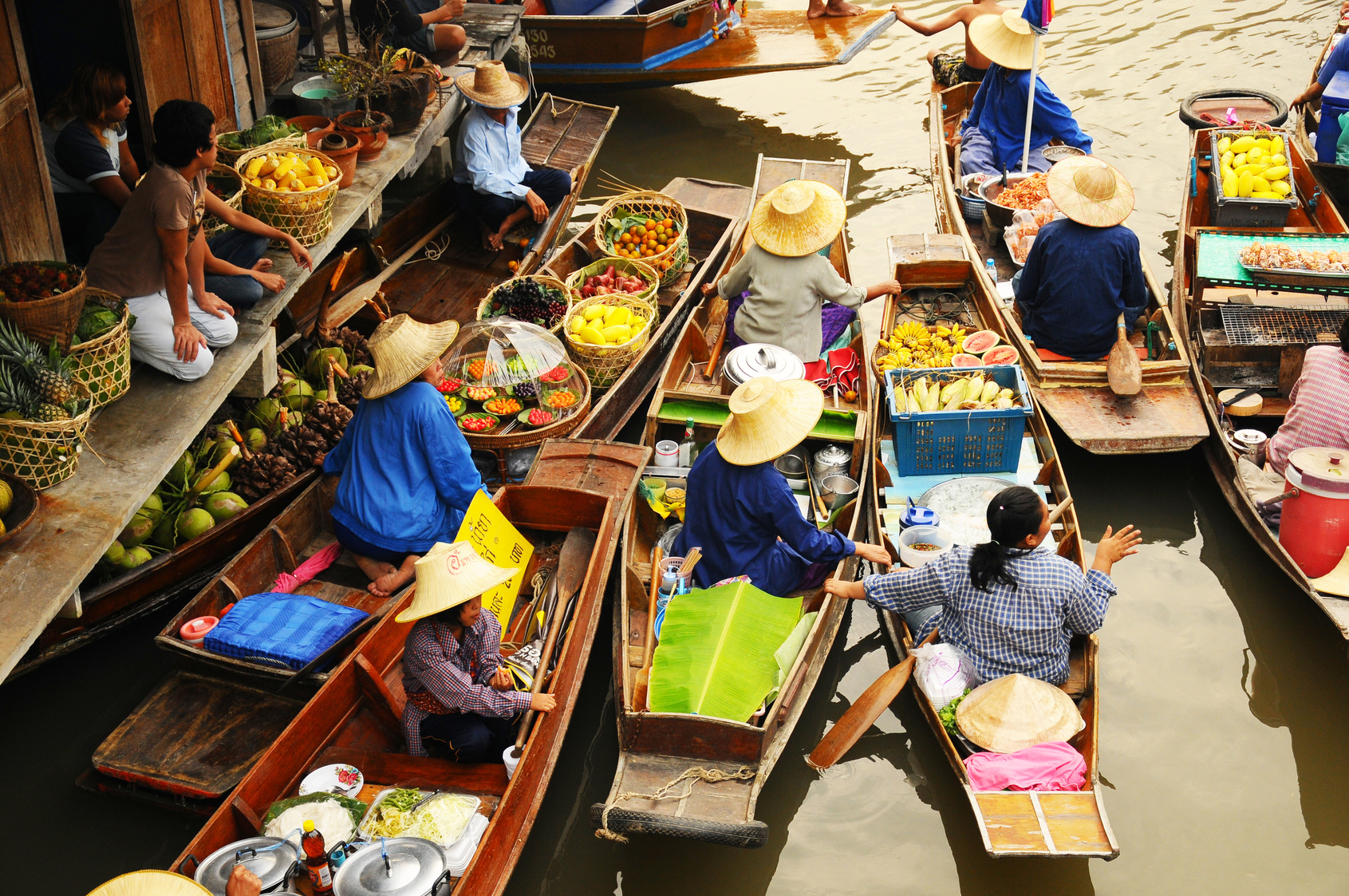
National parks and nature – Thailand has more than 120 national parks and marine parks packed with incredible wildlife, exotic birds and plants, jungles and the naturally spectacular. Quite which you opt for will depend on your own personal criteria. There are some which are hot-spots for seeing elephants in the wild, others which are known for their incredible trekking opportunities while others still offer super-easy access for spotting anything from brightly plumaged birds to vast troupes of monkeys.
Massage – Thailand is a land of massage with everything from a quick foot massage on a Bangkok street corner to full days of wellness pampering. Massage comes in many guises so you’ll need to learn the differences. For example, if you imagine yourself drifting gently off to sleep as soothing hands work out a knot or two you might want to avoid a Thai massage which although effective is anything but relaxing. If you are interested in learning the art of massage for yourself there are heaps of classes, courses and schools, especially around the Chiang Mai area.

